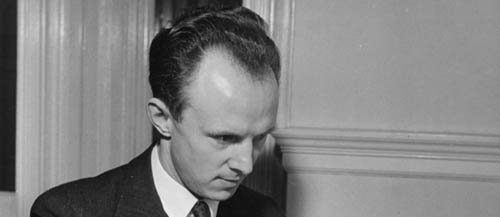One morning in October 1931, the twelve-year-old John Wilson’s life was to change forever. In a chemistry lesson at the Scarborough High School for Boys, he and his classmates had to carry out an experiment.
“I was sitting on a high stool, playing the blue flame from the Bunsen burner onto the test-tube when it suddenly exploded,” he said. “The chemicals had been wrongly labelled and it produced an explosive mixture.”
Whole rows of bottles were shattered, covering the pupils with glass. A boy was blinded in one of his eyes, John Wilson blinded in both. He always maintained that he did not think the event was tragic. He said it was catastrophic for his parents, and a lot of time was spent soothing their anxieties. He was far more accepting, and constantly referred to his blindness as nothing more than a “confounded nuisance.”
The Oxford years
Sir John enrolled at Oxford University in 1937, and had to quickly adapt to a huge, bustling town. He had not used a white cane before and nor would he for years to come, but instead relied on a sharp sense of hearing and what he called his ‘obstacle sense’.
He was one of 18 students to obtain a Second Class degree in Law.
At the age of 22 Sir John got his first job, as Assistant Secretary at the National Institute for the Blind. He found wartime London exciting – provided you weren’t being hit by the bombs! In the ensuing years he moved up the ranks until he was a player on the international stage. It was during these years that he married his wife Jean.
How it all started
In 1946-7 he took part in an epic nine-month tour of the African and Middle Eastern territories in what was then the British Empire. Shocked at the scale of blindness he witnessed, he returned determined to do something about it. However the National Institute, for whom he worked, saw the task as being outside its domestic remit. So Sir John began plans to establish a non-government organisation to address the prevention of blindness, and provide rehabilitation of those whose sight couldn’t be saved.
And so on 5 January 1950, the British Empire Society for the Blind, as Sightsavers was originally known, was born!
Sir John was certainly an inspiring man, campaigning up until his death in 1999 for the cure and prevention of blindness, and advocating for the rights of people who are blind. In 1955 he was made an OBE, and in 1975 was knighted, to name just two of the many awards he received for transforming the lives of so many people. His legacy is not only the work that Sightsavers continues to do to this day, but he will also be remembered for setting up other important organizations such as the the International Agency for the Prevention of Blindness (IAPB) and Impact, that addresses the issue of avoidable disability.
“John’s aspiration was that one day the charity (Sightsavers) would be powerful enough to really be heard worldwide,” said Lady Jean Wilson OBE, Sir John’s widow and an Honorary Fellow of the of the Royal College of Ophthalmologists, “big enough to span continents, but yet simple enough that it would reach into an African village and do something worthwhile there….If he looked back he would be appreciative of the incredible number of people in so many countries who have given their money, time, skills to bring the charity to where it is today.”
Credits: http://www.sightsavers.org/


Facebook comments